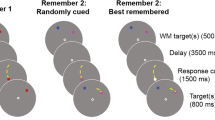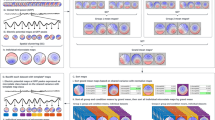Abstract
The neural mechanisms underlying spatial cognition in the context of exploring realistic city maps are unknown. We conducted a novel brain imaging study to address the question of whether and how features of special importance for map exploration are encoded in the brain to make a spatial decision. Subjects explored by eyes small city maps exemplifying five different street network types in order to locate a hypothetical City Hall, while neural activity was recorded continuously by 248 magnetoencephalography (MEG) sensors at high temporal resolution. Monitoring subjects’ eye positions, we locally characterized the maps by computing three spatial parameters of the areas that were explored. We computed the number of street intersections, the total street length, and the regularity index in the circular areas of 6 degrees of visual angle radius centered on instantaneous eye positions. We tested the hypothesis that neural activity during exploration is associated with the spatial parameters and modulated by street network type. All time series were rendered stationary and nonautocorrelated by applying an autoregressive integrated moving average model and taking the residuals. We then assessed the associations between the prewhitened time-varying MEG time series from 248 sensors and the prewhitened spatial parameters time series, for each street network type, using multiple linear regression analyses. In accord with our hypothesis, ongoing neural activity was strongly associated with the spatial parameters through localized and distributed networks, and neural processing of these parameters depended on the type of street network. Overall, processing of the spatial parameters seems to predominantly involve right frontal and prefrontal areas, but not for all street network layouts. These results are in line with findings from a series of previous studies showing that frontal and prefrontal areas are involved in the processing of spatial information and decision making. Modulation of neural processing of the spatial parameters by street network type suggests that some street network layouts may contain other types of spatial information that subjects use to explore maps and make spatial decisions.











Similar content being viewed by others
References
Aggelopoulos N, Rolls E (2005) Scene perception: inferior temporal cortex neurons encode the positions of different objects in the scene. Eur J Neurosci 22:2903–2916
Aguirre GK, Detre JA, Alsop DC, D’Esposito M (1996) The parahippocampus subserves topographical learning in man. Cereb Cortex 6:823–829
Box G, Jenkins G, Reinsel G (2008) Time series analysis: forecasting and control, 4th edn. Wiley, Hoboken
Chafee M, Averbeck B, Crowe D, Georgopoulos AP (2002) Impact of path parameters on maze solution time. Arch Ital Biol 140:247251
Christova P, Scoppa M, Peponis J, Georgopoulos AP (2012) Exploring small city maps. Exp Brain Res 223(2):207–217. doi:10.1007/s00221-012-3252-z
Clark P, Evans F (1954) Distance to nearest neighbor as a measure of spatial relationships in populations. Ecology 35:445–453
Crowe D, Averbeck B, Chafee M, Anderson J, Georgopoulos AP (2000) Mental maze solving. J Cogn Neurosci 12:813–827
Feierstein C, Quirk M, Uchida N, Sosulski D, Mainen Z (2006) Representation of spatial goals in rat orbitofrontal cortex. Neuron 51:495–507
Hillier B (1996) Space is the machine. Cambridge University Press, Cambridge
Jenkins GM, Watts DG (1968) Spectral analysis and its applications. Holden-Day, Oakland
Langheim FJ, Leuthold AC, Georgopoulos AP (2006) Synchronous dynamic brain networks revealed by magnetoencephalography. Proc Natl Acad Sci USA 103:455–459. doi:10.1073/pnas.0509623102
Leuthold AC (2003) Subtraction of heart artifact from MEG data: the matched filter revisited. 33rd Annual Meeting of the Society for Neuroscience. New Orleans, LA, 8–12 November. 863.15
Leuthold AC, Langheim FJ, Lewis SM, Georgopoulos AP (2005) Time series analysis of magnetoencephalographic data during copying. Exp Brain Res 164:411–422. doi:10.1007/s00221-005-2259-0
Maguire E, Frackowiak R, Frith C (1998) Recalling routes around london: activation of the right hippocampus in taxi drivers. J Neuroscience 17:7103–7110
O’Doherty J (2011) Contribution of the ventromedial prefrontal cortex to goal-directed action selection. Ann N Y Acad Sci 1239:118–129
Padoa-Schioppa C (2007) Orbitofrontal cortex and the computation of economic value. Ann N Y Acad Sci 1121:232–253
Padoa-Schioppa C (2011) Neurobiology of economic choice: a good-based model. Annu Rev Neurosci 34:333–359
Padoa-Schioppa C, Assad J (2006) Neurons in orbitofrontal cortex encode economic value. Nature 44:223–226
Peponis J, Wineman J (2002) Spatial structure of environment and behavior. In: Bechtel RB, Churchman A (eds) Handbook of environmental psychology, 2nd edn. Wiley, New York, NY
Prevosto V, Graf W, Ugolini G (2010) Cerebellar inputs to intraparietal cortex areas lip and mip: functional frameworks for adaptive control of eye movements, reaching, and arm/eye/head movement coordination. Cereb Cortex 20:214–228
Rochefort C, Lefort J, Rondi-Reig L (2013) The cerebellum: a new key structure in the navigation system. Front Neural Circuits 7:1–12
Spiers H, Maguire E (2006) Thoughts, behaviour, and brain dynamics during navigation in the real world. Neuroimage 31:1826–1840
Spiers H, Maguire E (2007) A navigational guidance system in the human brain. Hippocampus 17:618–626
Veneri G, Federico A, Rufa A (2014) Evaluating the influence of motor control on selective attention through a stochastic model: the paradigm of motor control dysfunction in cerebellar patient. Biomed Res Int 2014:1–13
Acknowledgments
This work was supported by the McKnight Presidential Chair in Cognitive Neuroscience, University of Minnesota (A.P.G.).
Author information
Authors and Affiliations
Corresponding author
Rights and permissions
About this article
Cite this article
Sakellaridi, S., Christova, P., Christopoulos, V. et al. Neural mechanisms underlying the exploration of small city maps using magnetoencephalography. Exp Brain Res 233, 3187–3200 (2015). https://doi.org/10.1007/s00221-015-4387-5
Received:
Accepted:
Published:
Issue Date:
DOI: https://doi.org/10.1007/s00221-015-4387-5




